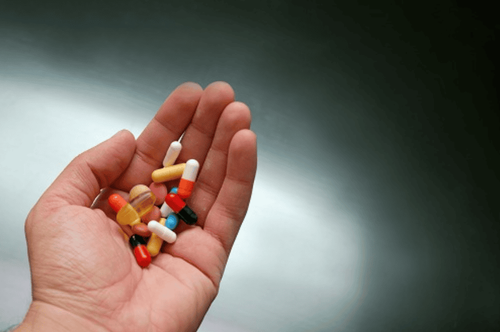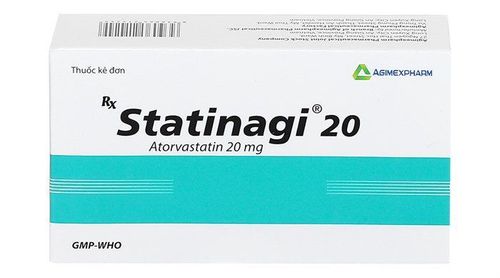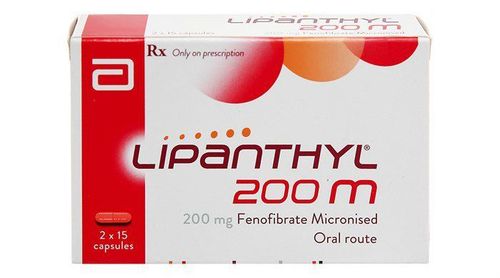This is an automatically translated article.
Colestrim Supra is a lipid-lowering drug, commonly used to treat hypercholesterolemia, secondary hyperlipoproteinemia. The drug helps to quickly relieve symptoms such as chest pain, dizziness ..., minimizing possible dangerous complications. In order for the drug to maximize its effectiveness, it should be used in combination with a reasonable diet.1. What is Colestrim supra?
Colestrim supra drug has the main ingredient is Fenofibrate 145mg, a derivative of fibric acid. The drug has the effect of inhibiting cholesterol biosynthesis in the liver, reducing atherogenic components, increasing the production of high-density lipoprotein, and at the same time reducing the blood triglyceride index. As a result, Colestrim supra significantly improves the distribution of cholesterol in the blood plasma.
With its uses, Colestrim supra is indicated for the following cases:
Hypercholesterolemia (type IIa), isolated endogenous hypertriglyceridemia (type IV), combined hyperlipidemia (type IIb & III) ) after having applied the right diet without any effect; Secondary hyperlipoproteinemia, persistent despite treatment of the cause (dyslipidemia in diabetes).
2. Instructions on how to take Colestrim supra
Treatment with Fenofibrate needs to be maintained continuously and combined with a very lipid-restricted diet, taking the drug with meals. In this way, patients can reduce up to 20-25% of total cholesterol and 40-50% of triglycerides in the blood.
2.1. Dosage for adults The initial dose is usually 200mg / day (taken once or divided into 2 times). If total blood cholesterol remains higher than 4 g/l, an increase in dose to 300 mg/day may be considered. Patients take 1 tablet of 300mg/day with the main meal or take 3 times, 1 capsule of 100mg each time with meals. The initial dose should be maintained until the blood cholesterol level returns to normal, after which the daily dose can be slightly reduced. It is necessary to maintain blood cholesterol testing every 3 months, if the blood lipid parameters increase again, the dose must be increased to 300mg/day. 2.2. Dosage for children Before using the drug, it is necessary to study carefully to determine the cause of hyperlipidemia in children. Treatment in combination with a strictly controlled diet may be attempted for 3 months. The maximum recommended dose for children is 5mg/kg/day. In some special cases (children with very high hyperlipidemia accompanied by clinical signs of atherosclerosis, whose parents have cardiovascular manifestations due to atherosclerosis before 40 years old, have xanthomas ...) A higher dose can be used but must be prescribed by a specialist. Notes on drug use:
Do not use Colestrim supra 300mg tablets for children; Tablets of this strength should only be used in patients requiring a dose of 300 mg/day. Take Colestrim supra at the time your doctor prescribes to ensure its effectiveness. If you miss a dose, take it as soon as you remember. However, if the interval between the next dose is too short, skip the missed dose and resume the dosing schedule. Do not take a double dose to make up for the missed dose.
3. Colestrim supra side effects
During treatment with Colestrim supra, users may experience the following problems:
Constipation; Diarrhea; Heartburn; Pain in the arms, back, or legs; Headache; Muscle pain, joint pain; Fever; blistering or peeling of the skin; Urticaria , rash; Stomach pain (especially the upper right part of the stomach); Nausea and vomiting; Difficulty breathing, coughing up blood... If any of the above symptoms or other unusual signs are present, the patient should contact and seek medical assistance immediately.
4. Notes when taking Colestrim supra
Colestrim supra is contraindicated in the following cases:
Severe renal failure; Severe liver dysfunction; Children under 10 years old; Hypersensitivity to any ingredient in the formulation. Special caution should be exercised in taking Colestrim supra in the following cases:
Elderly people; Pregnant women; Women who are breastfeeding. Other notes:
It is imperative to check the patient's liver and kidney function before starting Fenofibrate. Specifically: need to measure transaminase every 3 months, in the first 12 months of taking the drug. If SGPT (ALT) > 100 international units is found, the drug should be temporarily discontinued. For patients taking anticoagulants: When starting fenofibrate, the anticoagulant dose should be reduced to only 1/3 of the old dose and adjusted if necessary. More frequent monitoring of blood prothrombin is required. Adjust anticoagulant dose during and 8 days after discontinuation of fenofibrate. If blood lipid levels do not decrease significantly after 3-6 months of drug therapy, additional therapy or a change in therapy may be necessary. Prioritize low-fat, low-cholesterol diets during treatment with Colestrim supra. Adhere to the exercise regimens and strength training recommended by your doctor.
5. Colestrim supra . drug interactions
Co-administration of Colestrim supra with HMG-CoA reductase inhibitors (eg: Pravastatin, Simvastatin, Fluvastatin) increases the risk of muscle damage and acute pancreatitis; Do not combine drugs containing Fenofibrate with drugs with hepatotoxic effects (such as MAO inhibitors, perhexilin, maleate...); Combining fibrates with ciclosporin may increase the risk of muscle damage. Fenofibrate enhances the effect of anticoagulants and increases the risk of bleeding. Therefore, it is necessary to closely monitor prothrombin levels and adjust the dose of anticoagulants during fenofibrate therapy and also after 8 days of discontinuation. Above is information about Colestrim supra, patients need to consult their doctor, carefully read the instructions for use before taking the drug. When the medicine is no longer in use, you need to collect and dispose of it according to the manufacturer's instructions.
Please dial HOTLINE for more information or register for an appointment HERE. Download MyVinmec app to make appointments faster and to manage your bookings easily.













